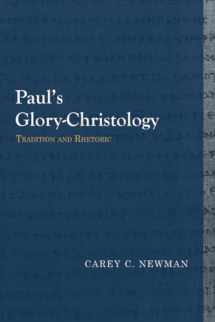
Paul’s Glory-Christology: Tradition and Rhetoric (Library of Early Christology)
ISBN-13:
9781481307963
ISBN-10:
1481307967
Edition:
Reprint
Author:
Carey C. Newman
Publication date:
2017
Publisher:
Baylor University Press
Format:
Paperback
323 pages
Category:
Churches & Church Leadership
,
History
,
Christian Books & Bibles
FREE US shipping
Book details
ISBN-13:
9781481307963
ISBN-10:
1481307967
Edition:
Reprint
Author:
Carey C. Newman
Publication date:
2017
Publisher:
Baylor University Press
Format:
Paperback
323 pages
Category:
Churches & Church Leadership
,
History
,
Christian Books & Bibles
Summary
Paul’s Glory-Christology: Tradition and Rhetoric (Library of Early Christology) (ISBN-13: 9781481307963 and ISBN-10: 1481307967), written by authors
Carey C. Newman, was published by Baylor University Press in 2017.
With an overall rating of 4.5 stars, it's a notable title among other
Churches & Church Leadership
(History, Christian Books & Bibles) books. You can easily purchase or rent Paul’s Glory-Christology: Tradition and Rhetoric (Library of Early Christology) (Paperback) from BooksRun,
along with many other new and used
Churches & Church Leadership
books
and textbooks.
And, if you're looking to sell your copy, our current buyback offer is $1.36.
Description
Glory formed an essential part of early Christianity’s christological vocabulary. Along with "word," "image," and "wisdom," Glory ( doxa) language worked to define the identity, status, and even uniqueness of Christian belief in Jesus. In Paul’s Glory-Christology author Carey C. Newman, using methodology developed in semantics, semiotics, and literary theory, examines the origin and rhetoric of Paul’s Glory-language. Newman divides the investigation into three distinct tasks: (1) to plot the tradition-history of Glory that formed part of Paul’s linguistic world, (2) to examine Paul’s letters, in light of the reconstructed tradition-history of Glory, in order to discern the rationale of Paul’s identification of Christ as Glory, and (3) to map out the implications of such an identification for Paul’s theological and rhetorical strategy. Newman reaches four conclusions for understanding Paul. First, Paul inherited a symbolic universe with signs already full of signification. Second, awareness of the connotative range of a surface symbol aids in discerning Paul’s precise contingent strategy. Third, knowing a symbol’s referential power defines and contributes to the deeper structure of Paul’s theological grammar. Finally, the heuristic power within the construals of the Glory tradition coalesce in Paul’s Christophany and thus provide coherence at the deepest level of Paul’s Christology. Taken together, these conclusions reveal that nothing less than Paul’s declaration of Jesus as God is expressed in his designation of Jesus as Glory.


We would LOVE it if you could help us and other readers by reviewing the book
Book review

Congratulations! We have received your book review.
{user}
{createdAt}
by {truncated_author}


